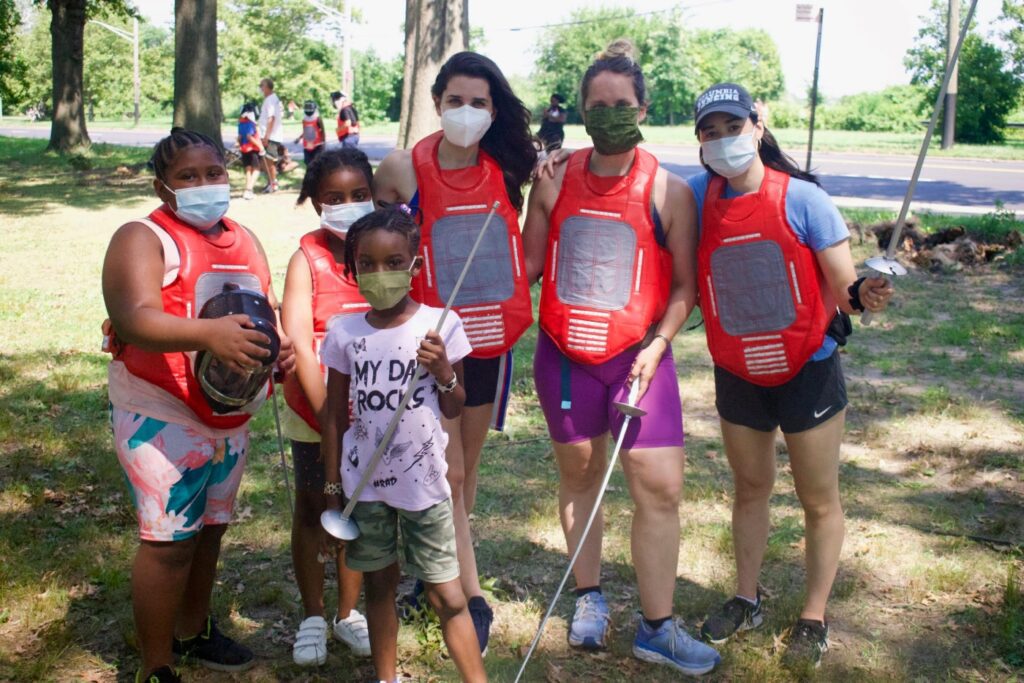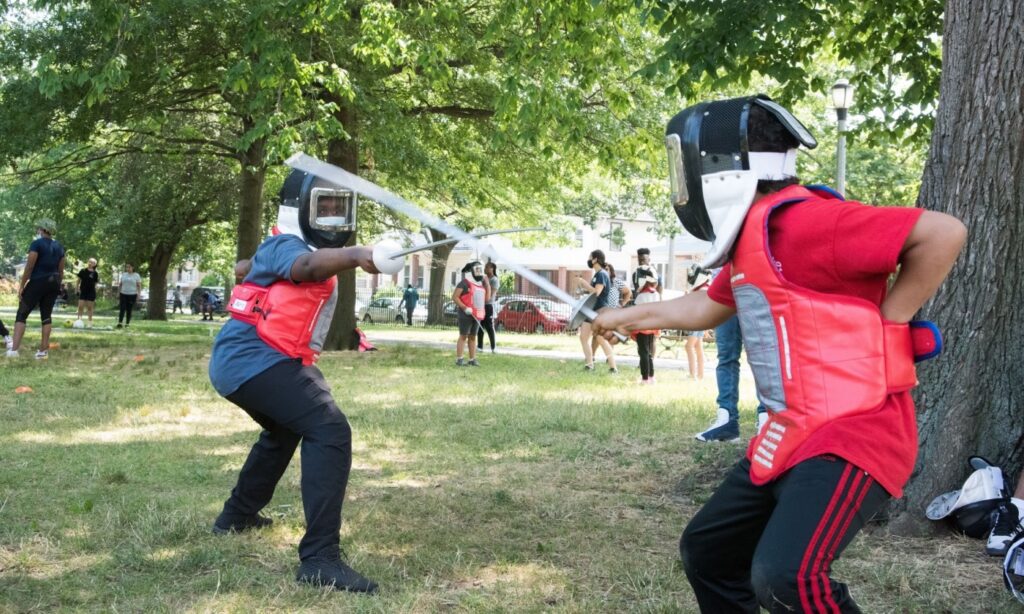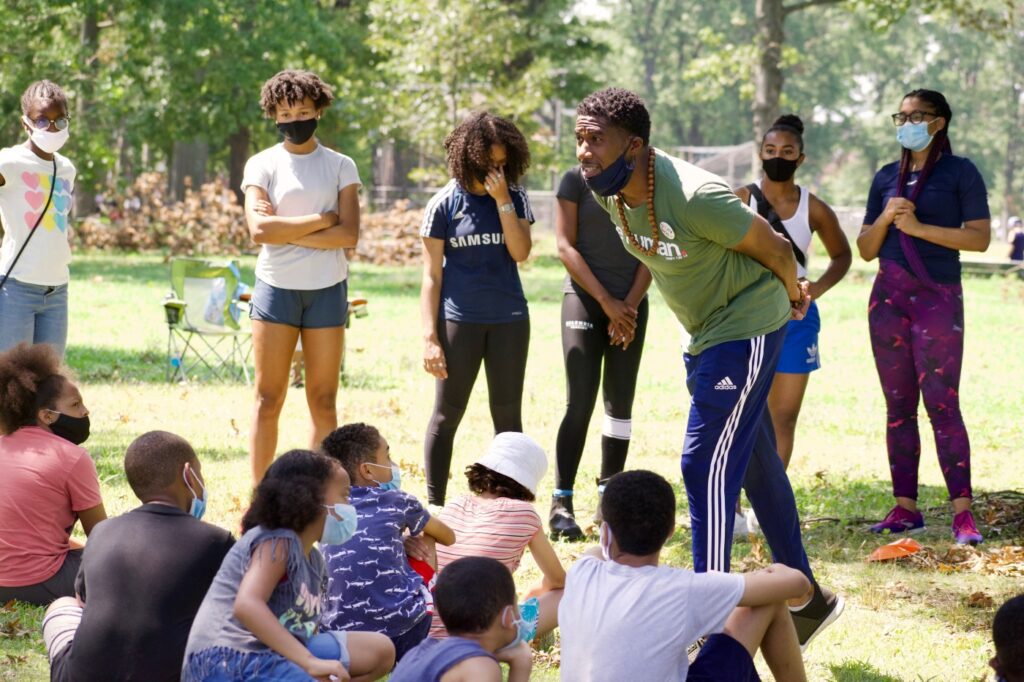One of the aftereffects of the Olympic Games is usually a renewed attention on sports usually relegated to the fringes of U.S. athletics. Swimmer Katie Ledecky broke a world record in Tokyo and has won two gold and two silver medals. Gymnast Simone Biles shined a spotlight on athletes’ mental health. And Lee Kiefer became the first American foil fencer to take home an individual gold medal.
The Olympics is that rare moment when the country takes their eyes off the NFL, NBA, and MLB, and focuses instead on the USFA, USAG, and USA Swimming, among others.
That’s good news for niche sports programs around the country that are trying to lift up underserved communities. Nzingha Prescod, the first Black woman to win a Senior World Champion medal in fencing and a two-time Olympian, is one of those.
Prescod announced her retirement because of health issues in 2020, in the run-up to the (eventually postponed) Tokyo Games. But later that year, she started paying forward her own good fortune through a new program, Fencing in the Park.
“I had a mission to give back to my people and the kids in my neighborhood, because it was just such an important part of my development,” Prescod said.


Prescod, a native of the Flatlands section of Brooklyn, New York, started fencing at a young age. In 2001, however, she had limited access to sports like fencing in her neighborhood. As a child, she joined the club at the nonprofit Peter Westbrook Foundation, whose mission is to enrich the lives of underprivileged youth through fencing, a sport historically more associated with upper-class White athletes.
At Westbrook, Prescod had access to world-class coaches and training facilities that helped propel her career within the sport. She later attended Columbia University on the school’s fencing team and was on the U.S. Olympic team in 2012 and 2016.
Fencing In The Park offers four free programs for kids from underrepresented communities. Right now the organization’s core program is called the summer series, which helps expose under-represented communities of Brooklyn to the sport. From there, offerings expand to school programs (in which the organization partners with public, charter, and independent schools) as well as programs to fence recreationally at a local fencing club. And if kids are really into it, they can participate in a high-performance program that trains for competition.
The need for programs like Fencing in the Park is growing, and it’s daunting. According to a pre-pandemic report from Aspen Institute, the household income disparity between children who play sports and those who don’t is staggering. In 2018, kids from households with annual incomes below $25,000 were 21% less likely to play sports than children from households with income above $100,000.
Part of that problem can be attributed to the cost of sports. According to the survey, the average family spends almost $700 on sports per child per year. But in some equipment-heavy sports such as fencing, that can add up quickly to thousands of dollars for club membership fees, lessons and classes, gear, and competition-related expenses. Even starter kits can run hundreds of dollars. Without programs like Fencing In The Park, even exposure to the sport would be unobtainable for many low-income kids.

There is similar momentum in the sport of gymnastics to provide more equitable opportunities. Hall of Fame gymnast Wendy Hilliard, the first Black rhythmic gymnast on the U.S. national team, now leads the Wendy Hilliard Gymnastics Foundation. Since 1996, the foundation has provided low-cost gymnastics classes to underprivileged youth in New York’s Harlem neighborhood.
“When you go down the list of college sports, the nontraditional sports definitely is an easier path because there are fewer students doing them. But on the other side of that, there are fewer opportunities to learn and train,” Hilliard said.
Like fencing, gymnastics has more built-in costs that some more popular sports don’t have because of the specialized facilities needed. They’re not as commonplace, nor as cheap (or even free), the way neighborhood basketball or tennis courts may be. That presents more significant barriers to entry.
Hilliard has been dismantling those hurdles in gymnastics, lifting up kids who wouldn’t otherwise have access to the national stage, including some who qualified for the U.S. national team. Her foundation has served more than 2,000 kids so far, and in 2016, opened a second center in her former home of Detroit.
This past spring, Hilliard and Prescod both joined other New York City sports leaders to lobby for the creation of the Mayor’s Office of Sports, Wellness, and Recreation. Effective August 21, the office would be responsible for both building and supporting youth sport programs throughout the city, and expanding access to disadvantaged communities across the five boroughs.
This isn’t just happening in New York. Many schools and universities offer crew rowing programs, for example, to meet their Title IX requirements, which mandates an equal amount of athletic offerings for women and men.
In part, that’s why Steve Perry, head coach and program director at Dallas United Crew, launched Row Dallas, a program to draw in middle school-age athletes who would otherwise find the sport inaccessible because of the financial and geographical constraints that come with it.
It is game-changing for teens who otherwise wouldn’t be college bound.
“The sport that has so many open ends for their future,” Perry said. “A huge number of women end up getting scholarships.” The Connecticut Post has reported that nearly half of all collegiate women rowers receive an athletic scholarship.
Perry knows the college landscape. He formerly coached rowing teams at the U.S. Naval Academy, Dartmouth College, and Cornell University. He now works alongside the Dallas Independent School District to offer Row Dallas programming for free to students, and even arranges transportation for children from school to the boathouse. Following in the footsteps of programs like it, such as STEM to Stern, a program that serves under-represented youth in Milwaukee, Row Dallas also provides tutoring in math and language arts.
There is a direct correlation between athletic involvement and social mobility. A study from the Harvard Kennedy School of Public Policy found that upper-middle-class students are more likely to take part in extracurriculars than their lower-income counterparts. By targeting wealthier students, programs have been able to ramp up the costs associated with joining a team, which creates even more significant barriers to entry, limiting yet another avenue for social mobility.
For that reason, more sports organizations are taking a holistic approach by including academic programming alongside physical education. In the San Francisco Bay Area, Mulatto Meadows is helping bring equestrian to children in disenfranchised communities of the East Bay. The program includes basic horseback riding lessons, but the long-term riding program also requires students to maintain a 3.0 GPA and be involved in community service.
The program teaches both foundations of horseback riding and also provides options for more long-term riding opportunities, which the organization’s program director, Bri Noble, asserts is therapeutic for the communities she serves.
“Many of our families, because of the location we’re in, experience so much trauma and death around them,” Noble said, adding, “We bring in the horses to help assist in the therapy process that’s going on.”
Noble’s focus is more on therapeutic riding than on preparing for college, but nonetheless is providing a needed service in these communities. “We use horses as a medium to inspire positivity in our communities, and that really just means so many different things,” she said.
The hope is that through programs like these introducing niche sports to children who might not otherwise have access to them, inspiration is carried forward by future generations of youth athletes. And if the U.S. Olympic team in Tokyo is any example, some of those athletes can go far in life.
|
Andy Hirschfeld is a reporter focusing on cost of living issues. He writes for publications including Al Jazeera English, Observer, OZY, Salon, CNBC and many others. He’s also the anchor for the nationally syndicated business news program Business Brief. He is a member of ONA. He is based in New York City and speaks English. He can be reached at [email protected]
|
https://ift.tt/3CM6muC
Sport
Bagikan Berita Ini
















0 Response to "A Former Olympic Fencer Brings Her Sport Back to Her Community - YES! Magazine"
Post a Comment